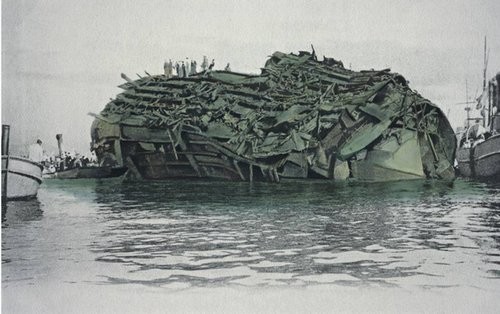Elger Esser
16 Sep - 23 Oct 2010
ELGER ESSER
"Sin Tiempo"
Opening: Thursday 16th September 2010 / 20 pm
Exhibition: from September 16th to October 23rd 2010
The works of German artist Elger Esser presented in the exhibition make use of techniques applied in the early days of photography, like the process of hand-colouring a black and white photograph or picking up on the reproduction technique of traditional heliogravure.
Esser's growing collection of 19th century postcards, shows his preference for the French costal region, which has since the early beginning of his own photography been an area of special interest to him. The archive serves him as a source of inspiration, from which he also generates works directly, by enlarging a certain part of the postcard.
In his large scale, unique copies of 'Wrecks' Esser takes up the process of hand-colouring a black and white photograph. Certain details of the large scale dimensional work are hand-coloured in a painter's studio, as shown in the two works '0 Toulon' and '17 Casablanca' that are on display at the exhibition.
The main part of the exhibition contains a group of six heliogravures. Heliogravure is a noble method of printing a photographic image and was used mainly for high quality reproduction in publication. Esser picks up on the traditional reproduction technique and the results are prints with all gradations between deep black and pure white like the fineness of a photograph.
Inspired by Marcel Proust’s imaginary town of Combray, described in the book 'À la recherche du temps perdu' (Search of Lost Time), the heliogravures of French landscapes and villages can be seen as the artist personal search of Combray. All the places are familiar to the viewer; they seem to be known to our memory, although we have never laid eyes on them before.
In combining photographic techniques from the past with the artist's photographs taken nowadays, Esser's works start to smudge the line between now and then, creating places removed from time.
Elger Esser studied photography under Bernd and Hilla Becher at the Düsseldorf Art Academy. His works are in numerous institutional collections, including the Metropolitan Museum of Art New York, Solomon R. Guggenheim Museum New York, Kunsthaus Zürich, Stedelijk Museum Amsterdam, Centre Pompidou Paris, Städtische Galerie im Lenbachhaus München, Museum der Moderne Salzburg.
"Sin Tiempo"
Opening: Thursday 16th September 2010 / 20 pm
Exhibition: from September 16th to October 23rd 2010
The works of German artist Elger Esser presented in the exhibition make use of techniques applied in the early days of photography, like the process of hand-colouring a black and white photograph or picking up on the reproduction technique of traditional heliogravure.
Esser's growing collection of 19th century postcards, shows his preference for the French costal region, which has since the early beginning of his own photography been an area of special interest to him. The archive serves him as a source of inspiration, from which he also generates works directly, by enlarging a certain part of the postcard.
In his large scale, unique copies of 'Wrecks' Esser takes up the process of hand-colouring a black and white photograph. Certain details of the large scale dimensional work are hand-coloured in a painter's studio, as shown in the two works '0 Toulon' and '17 Casablanca' that are on display at the exhibition.
The main part of the exhibition contains a group of six heliogravures. Heliogravure is a noble method of printing a photographic image and was used mainly for high quality reproduction in publication. Esser picks up on the traditional reproduction technique and the results are prints with all gradations between deep black and pure white like the fineness of a photograph.
Inspired by Marcel Proust’s imaginary town of Combray, described in the book 'À la recherche du temps perdu' (Search of Lost Time), the heliogravures of French landscapes and villages can be seen as the artist personal search of Combray. All the places are familiar to the viewer; they seem to be known to our memory, although we have never laid eyes on them before.
In combining photographic techniques from the past with the artist's photographs taken nowadays, Esser's works start to smudge the line between now and then, creating places removed from time.
Elger Esser studied photography under Bernd and Hilla Becher at the Düsseldorf Art Academy. His works are in numerous institutional collections, including the Metropolitan Museum of Art New York, Solomon R. Guggenheim Museum New York, Kunsthaus Zürich, Stedelijk Museum Amsterdam, Centre Pompidou Paris, Städtische Galerie im Lenbachhaus München, Museum der Moderne Salzburg.

